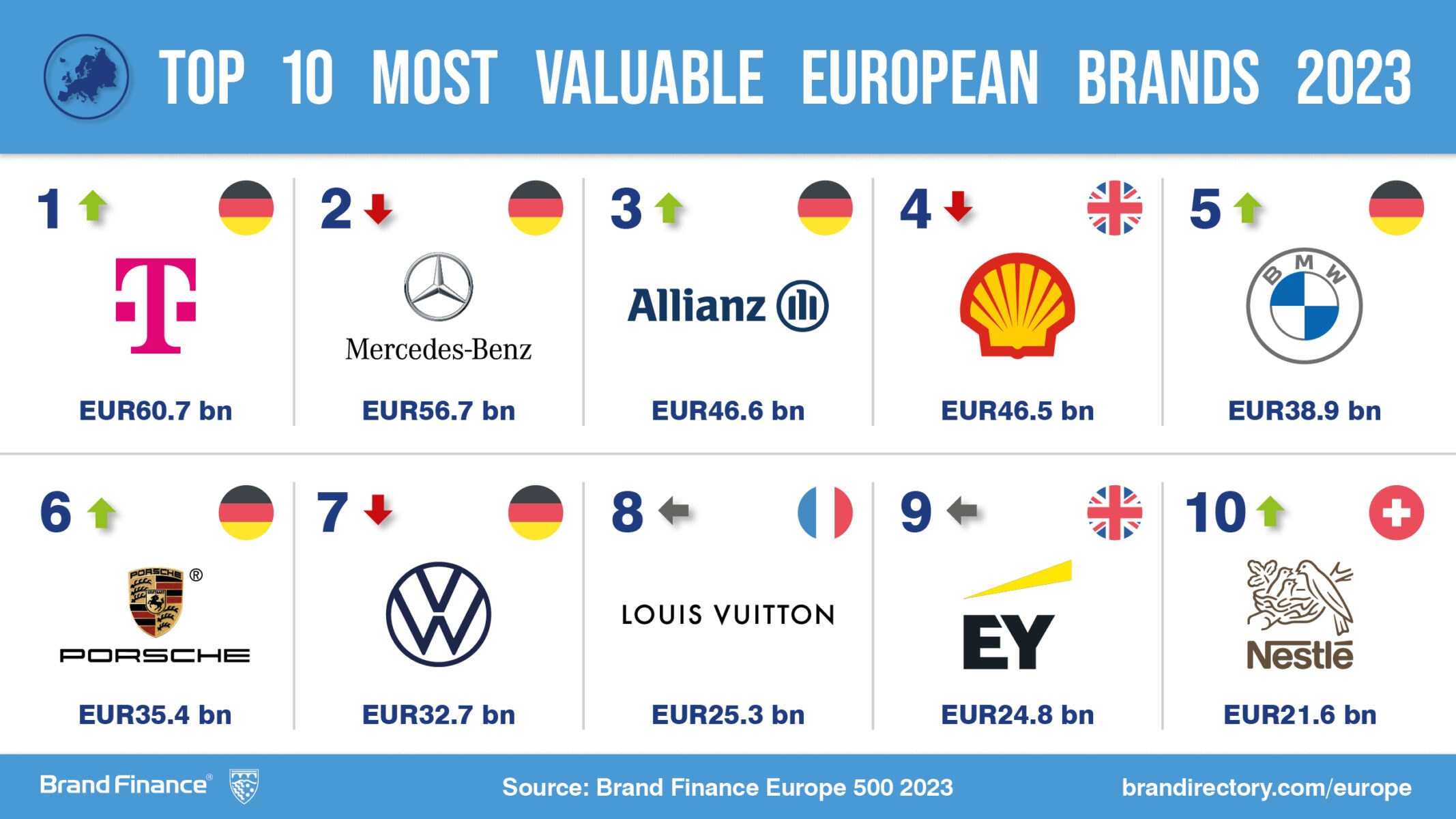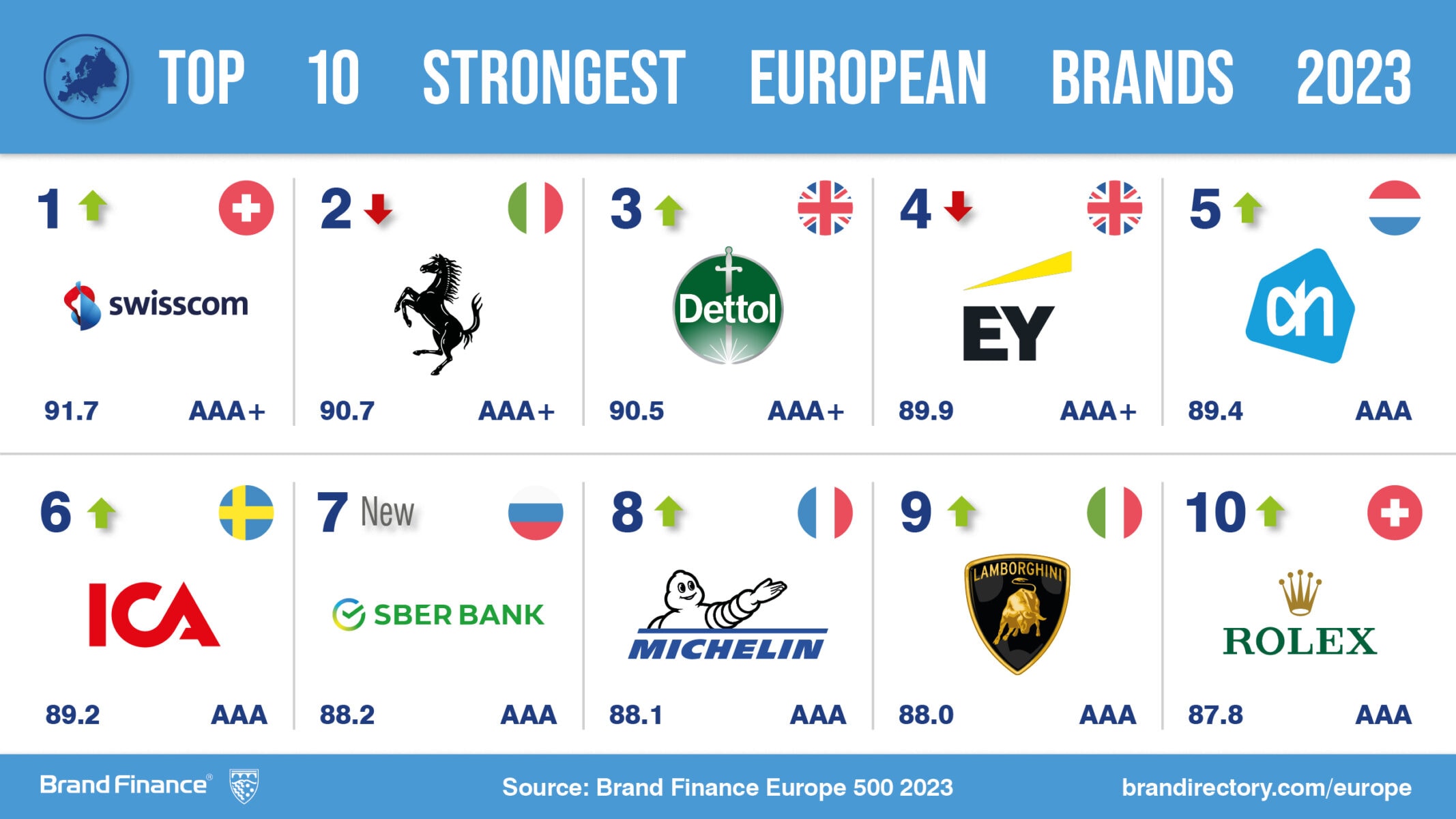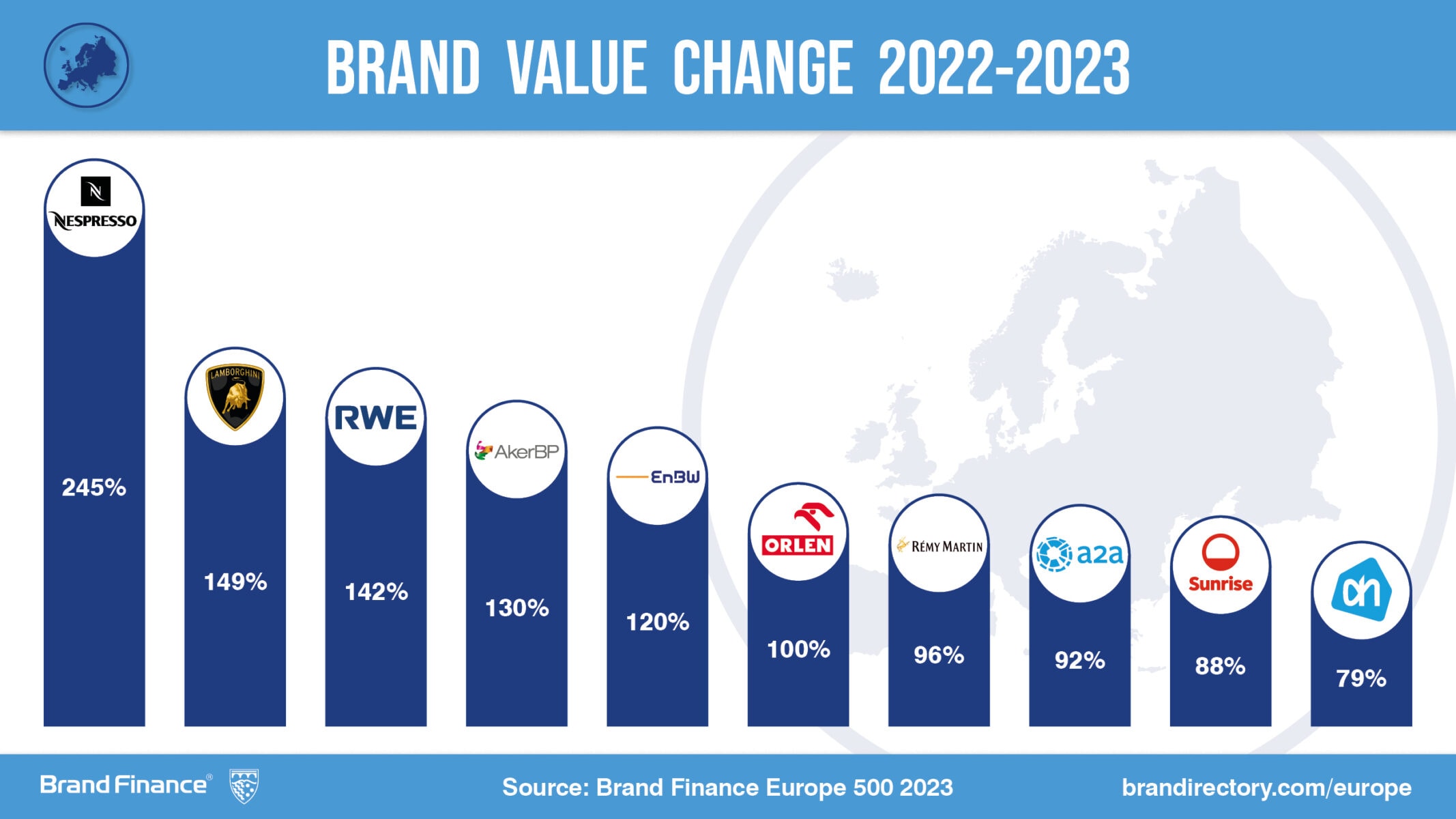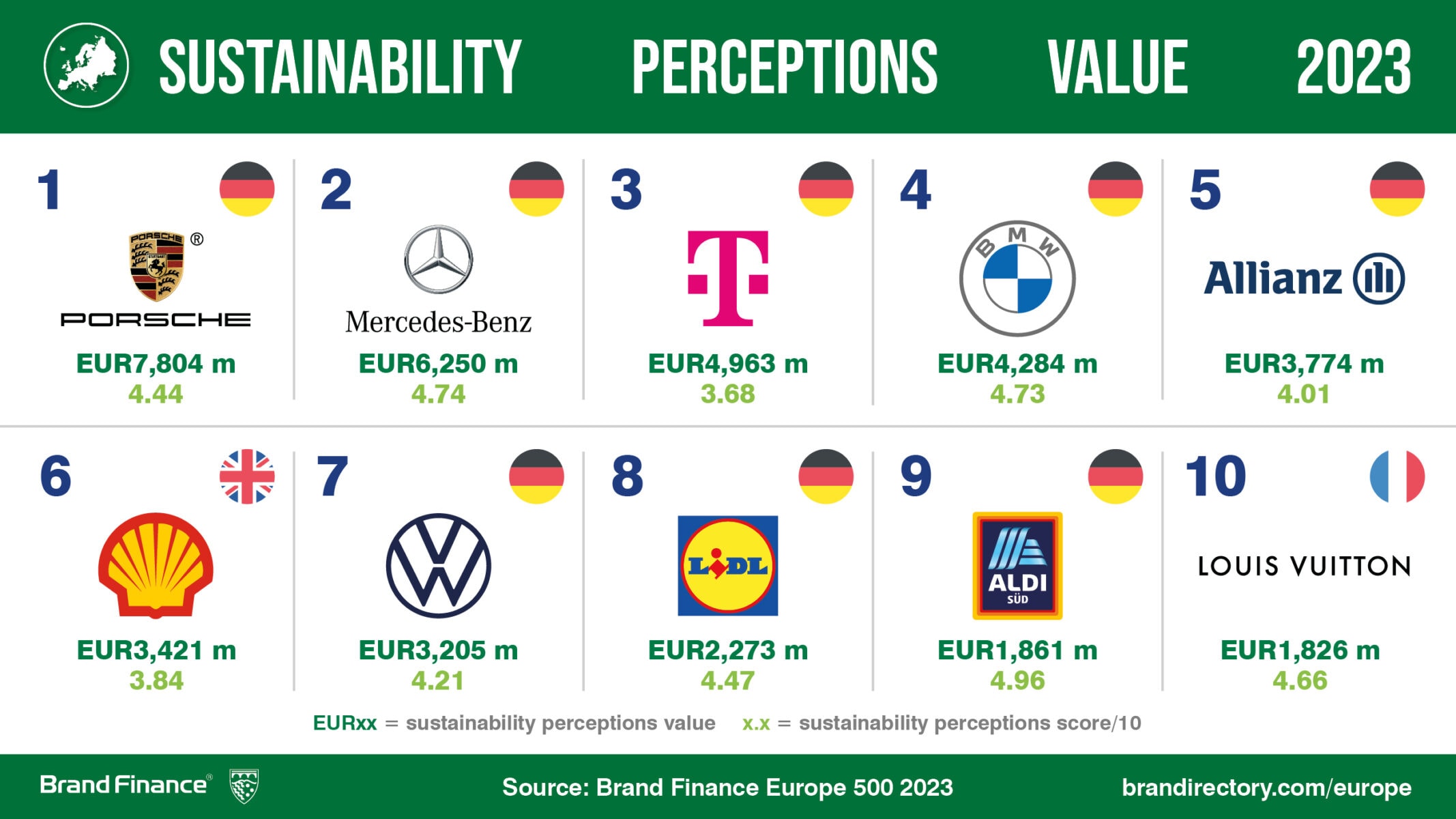View the full Brand Finance Europe 500 2023 report here
German telecoms provider Deutsche Telekom (brand value up 17% to EUR60.7 billion) surpasses former champion Mercedes-Benz to become the most valuable European brand, according to a new report from leading brand valuation consultancy, Brand Finance.
Every year, leading brand valuation consultancy Brand Finance puts 5,000 of the biggest brands to the test, and publishes over 100 reports, ranking brands across all sectors and countries. The world’s top 500 most valuable and strongest European brands are included in the annual Brand Finance Europe 500 2023 ranking.
Building on its success as the second most valuable telecoms brand globally, Deutsche Telekom’s latest title as the most valuable European brand comes as a result of strong revenue growth across European markets and increasing customer numbers. The latter has also significantly propelled the brand’s growth in the US, which has seen record customer additions.
David Haigh, Chairman and CEO of Brand Finance commented:
“Deutsche Telecom has had a remarkable year, surpassing Mercedes-Benz to become the champion of European brands. Thanks to its rebranding efforts, the German telecoms giant has successfully enhanced its brand visibility and strength across diverse international markets and consumer segments, aligning with its ambition to become a market leader, not just in Europe, but globally.”

Mercedes-Benz (brand value up 8% to EUR56.7 billion) leads the pack for luxury automobiles as the second-most valuable European brand. Despite dropping to second place this year, the brand continues to enjoy international growth. This growth can be attributed to innovative new product developments, reflecting an industry-wide transition to electric vehicles and an all-electric future.
Allianz Group (brand value up 20% to EUR46.6 billion) is this year’s third-most valuable European brand. Allianz's brand value has increased due to record results in revenue and operating profit in 2022, demonstrating particularly strong performance in the Property-Casualty, Life/Health, and Asset Management segments. Customer and employee satisfaction for the brand also reached an all-time high, solidifying its position as one of the world’s largest and most trusted financial institutions.
In addition to calculating brand value, Brand Finance also determines the relative strength of brands through a balanced scorecard of metrics evaluating marketing investment, stakeholder equity, and business performance. Compliant with ISO 20671, Brand Finance’s assessment of stakeholder equity incorporates original market research data from over 100,000 respondents in 38 countries and across 31 sectors.
Swisscom (brand value up 18% to EUR6.1 billion) is the strongest European brand. The Swiss telecoms giant has boosted its brand strength through its pioneering initiatives in the European 5G market, announcing its new Fixed Wireless Access 5G service for business customers at the end of last year. Swisscom is committed to boosting its brand strength and global reputation through the establishment of more physical shops worldwide, as well as revising its branding efforts, both in stores and online.

Nespresso (brand value up 245% to EUR2.8 billion) is a new entrant this year as the European brand with the biggest change in brand value. Well-reputed for quality and luxury, Nespresso has maintained consumer loyalty by consistently developing new and innovative products across its coffee capsule and machine ranges.
In addition, Nestlé changed it's reporting to enable enhanced transparency on financial information and an identification of Nespresso's revenue separate from other brands in the portfolio. This caused a boost in brand value against estimated sales volumes from the year before. Improved financial reporting on brands is best practice for management to enable investors and third-party users of accounts to add accountability on brand management.

Porsche (brand value up 22% to EUR35.4 billion) has the highest Sustainability Perceptions Value of any brand included in the Europe 500 ranking, at EUR7.8 billion. It should be noted that Porsche’s position at the top of the SPV table is not an assessment of its overall sustainability performance, but rather indicates how much brand value it has tied up in sustainability perceptions. That said, Brand Finance research finds that sustainability is a key driver of choice for consumers in the luxury sector, at 22.9%. Despite the well-known negative environmental consequences associated with the automotive industry, Porsche is one of several luxury auto brands incorporating ESG (Environmental, Social, and Governance) principles into its communication strategies, thereby bolstering favourable consumer perceptions. Porsche has committed to offering more electric and hybrid vehicles, promoting cleaner energy sources, and implementing innovative technologies to improve energy efficiency and reduce emissions.

View the full Brand Finance Europe 500 2023 report here
ENDS
Brand Finance is the world’s leading brand valuation consultancy. Bridging the gap between marketing and finance, Brand Finance evaluates the strength of brands and quantifies their financial value to help organisations make strategic decisions.
Headquartered in London, Brand Finance operates in over 25 countries. Every year, Brand Finance conducts more than 6,000 brand valuations, supported by original market research, and publishes over 100 reports which rank brands across all sectors and countries.
Brand Finance also operates the Global Brand Equity Monitor, conducting original market research annually on 6,000 brands, surveying more than 175,000 respondents across 41 countries and 31 industry sectors. By combining perceptual data from the Global Brand Equity Monitor with data from its valuation database — the largest brand value database in the world — Brand Finance equips ambitious brand leaders with the data, analytics, and the strategic guidance they need to enhance brand and business value.
In addition to calculating brand value, Brand Finance also determines the relative strength of brands through a balanced scorecard of metrics evaluating marketing investment, stakeholder equity, and business performance, compliant with ISO 20671.
Brand Finance is a regulated accountancy firm and a committed leader in the standardisation of the brand valuation industry. Brand Finance was the first to be certified by independent auditors as compliant with both ISO 10668 and ISO 20671 and has received the official endorsement of the Marketing Accountability Standards Board (MASB) in the United States.
Brand is defined as a marketing-related intangible asset including, but not limited to, names, terms, signs, symbols, logos, and designs, intended to identify goods, services, or entities, creating distinctive images and associations in the minds of stakeholders, thereby generating economic benefits.
Brand strength is the efficacy of a brand’s performance on intangible measures relative to its competitors. Brand Finance evaluates brand strength in a process compliant with ISO 20671, looking at Marketing Investment, Stakeholder Equity, and the impact of those on Business Performance. The data used is derived from Brand Finance’s proprietary market research programme and from publicly available sources.
Each brand is assigned a Brand Strength Index (BSI) score out of 100, which feeds into the brand value calculation. Based on the score, each brand is assigned a corresponding Brand Rating up to AAA+ in a format similar to a credit rating.
Brand Finance calculates the values of brands in its rankings using the Royalty Relief approach – a brand valuation method compliant with the industry standards set in ISO 10668. It involves estimating the likely future revenues that are attributable to a brand by calculating a royalty rate that would be charged for its use, to arrive at a ‘brand value’ understood as a net economic benefit that a brand owner would achieve by licensing the brand in the open market.
The steps in this process are as follows:
1 Calculate brand strength using a balanced scorecard of metrics assessing Marketing Investment, Stakeholder Equity, and Business Performance. Brand strength is expressed as a Brand Strength Index (BSI) score on a scale of 0 to 100.
2 Determine royalty range for each industry, reflecting the importance of brand to purchasing decisions. In luxury, the maximum percentage is high, while in extractive industry, where goods are often commoditised, it is lower. This is done by reviewing comparable licensing agreements sourced from Brand Finance’s extensive database.
3 Calculate royalty rate. The BSI score is applied to the royalty range to arrive at a royalty rate. For example, if the royalty range in a sector is 0-5% and a brand has a BSI score of 80 out of 100, then an appropriate royalty rate for the use of this brand in the given sector will be 4%.
4 Determine brand-specific revenues by estimating a proportion of parent company revenues attributable to a brand.
5 Determine forecast revenues using a function of historic revenues, equity analyst forecasts, and economic growth rates.
6 Apply the royalty rate to the forecast revenues to derive brand revenues.
7 Discount post-tax brand revenues to a net present value which equals the brand value.
Brand Finance has produced this study with an independent and unbiased analysis. The values derived and opinions presented in this study are based on publicly available information and certain assumptions that Brand Finance used where such data was deficient or unclear. Brand Finance accepts no responsibility and will not be liable in the event that the publicly available information relied upon is subsequently found to be inaccurate. The opinions and financial analysis expressed in the study are not to be construed as providing investment or business advice. Brand Finance does not intend the study to be relied upon for any reason and excludes all liability to any body, government, or organisation.
The data presented in this study form part of Brand Finance's proprietary database, are provided for the benefit of the media, and are not to be used in part or in full for any commercial or technical purpose without written permission from Brand Finance.